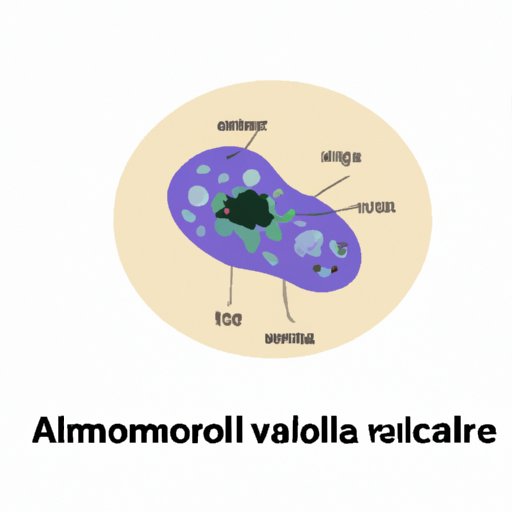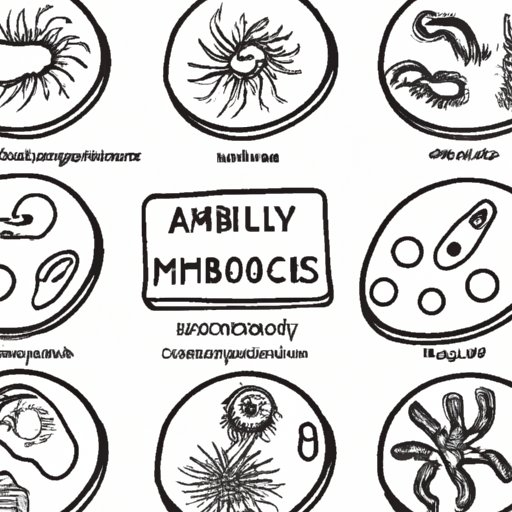I. Introduction
Amoebas are tiny, single-celled organisms that can be found in a variety of environments, including soil, water, and even in our own bodies. While many amoebas are completely harmless to humans, others can cause serious health problems and diseases. In this article, we’ll explore the fascinating world of amoebas, learning about their biology, unique characteristics, and their importance in the ecosystem. We’ll also delve into their impact on human health and disease, and the mysteries that still surround these tiny creatures.
II. Discovering the World of Amoebas: A Beginner’s Guide
Amoebas are a type of protist, which means they are eukaryotic organisms that are not plants, animals, or fungi. They are characterized by their shape-shifting abilities and their use of pseudopodia, which are extensions of their cell membrane that they use for movement and to capture food. Amoebas are classified into various groups based on their shape and the characteristics of their pseudopodia.
Amoebas can be found in a diverse range of environments, including soil, freshwater, saltwater, and even in the human body. They come in many different shapes and sizes, from the large and visible to the naked eye to the microscopic, and they play an important role in many ecosystems.
III. All You Need to Know About Amoebas and Their Role in the Ecosystem
Amoebas are important decomposers in many ecosystems, breaking down dead organic matter and recycling nutrients back into the soil. They are also predators of other microscopic organisms, such as bacteria, fungi, and other protists. This makes them an important part of the food chain in many environments.
Amoebas also play a critical role in shaping microbial communities. They can interact with other microorganisms through symbiotic relationships, where both organisms benefit. For example, some amoebas have bacteria living inside them that help with digestion. In other cases, amoebas can act as predators of harmful bacteria, providing a natural defense against infections.
IV. A Closer Look at the Biology and Life Cycle of Amoebas
Amoebas are single-celled organisms with a simple biology. They use pseudopodia to move and capture food, and they reproduce through a process called binary fission. Amoebas can also undergo sexual reproduction under certain conditions, which can contribute to genetic diversity.
There are many types of amoebas, each with their own unique characteristics. For example, some amoebas produce protective shells around themselves when they encounter harsh conditions, while others form multicellular colonies.
V. Uncovering the Unique Features of Amoebas and Their Importance in the World of Microorganisms
One of the most unique features of amoebas is their ability to form multicellular communities, called fruiting bodies. These structures can contain hundreds or even thousands of individual cells and are thought to help amoebas survive in stressful environments.
Amoebas also play an important role in symbiosis, where two different organisms interact in a way that benefits both. For example, some amoebas have a symbiotic relationship with algae, where they provide a protected environment for the algae to live and in turn receive nutrients produced by the algae.
VI. How Amoebas Shape Our Understanding of Evolution and Adaptation
Amoebas have contributed enormously to our understanding of evolution and adaptation. They are highly adaptable organisms that can change their behavior and morphology in response to environmental stress. This has led to the development of many different types of amoebas with diverse characteristics.
One particularly interesting aspect of amoebas is their ability to rapidly evolve resistance to drugs and other environmental stressors. This has made them a model organism for studying the evolution of resistance and for exploring new approaches to drug development.

VII. Amoebas: The Tiny Creatures with a Mighty Impact on Human Health and Disease
While many amoebas are harmless to humans, others can cause serious health problems and diseases. Some of the most common infections caused by amoebas include amoebic dysentery, brain-eating amoeba infections, and eye infections.
Treating infections caused by amoebas can be challenging because they are often resistant to many types of drugs. Prevention is the best strategy for avoiding amoeba-related illnesses, by practicing good hygiene and avoiding risky behaviors such as swimming in contaminated water.
VIII. Exploring the Mysteries of Amoebas: From Harmless Protists to Deadly Pathogens
Despite our knowledge of amoebas, there is still much that we don’t know. Some of the biggest mysteries include their origin and evolution, the mechanisms that allow them to form complex communities, and the ways in which they interact with other organisms.
Research into amoebas is ongoing, with new discoveries being made all the time. There is a great deal of interest in exploring the potential uses of amoebas for biotechnology, drug development, and more.
IX. Conclusion
Amoebas are a fascinating group of protists with a tremendous impact on the environment and human health. They are diverse, adaptable organisms that play a vital role in the ecosystem, and their unique characteristics have contributed to our understanding of evolution and adaptation. However, some types of amoebas can cause serious illnesses, and much work remains to be done to fully understand these tiny creatures and their complex interactions with other organisms. By learning more about amoebas, we can better appreciate their importance and take steps to protect ourselves and the environment from their potential harm.
